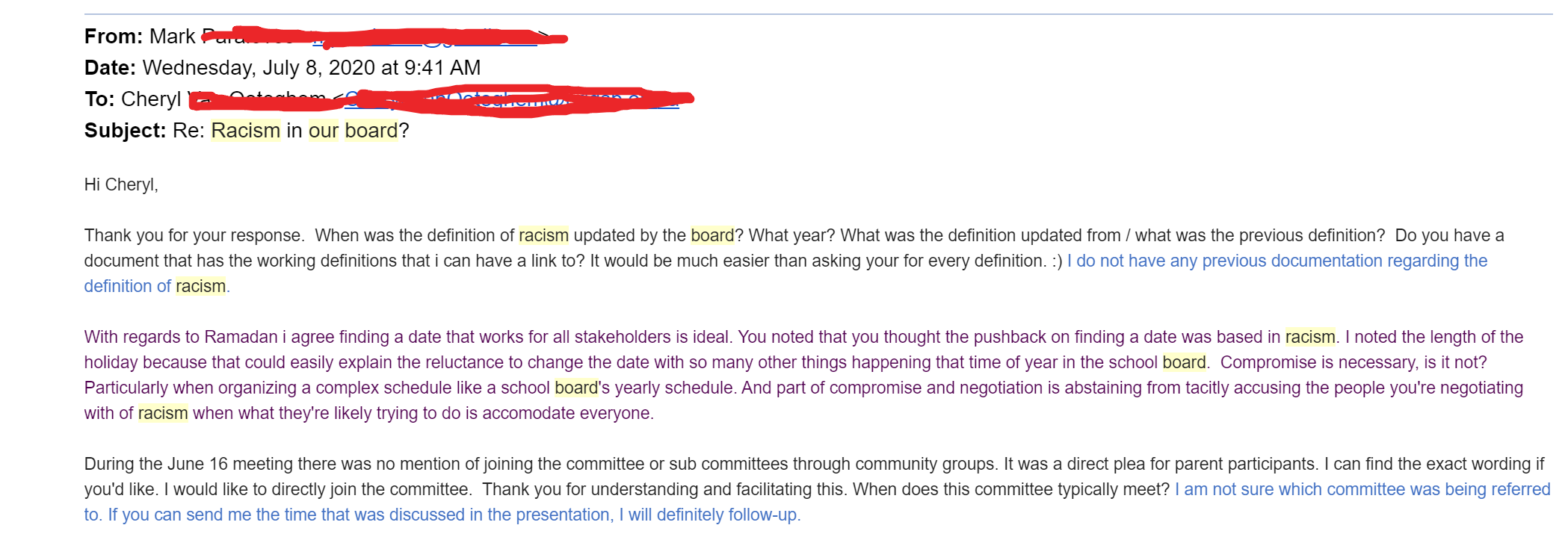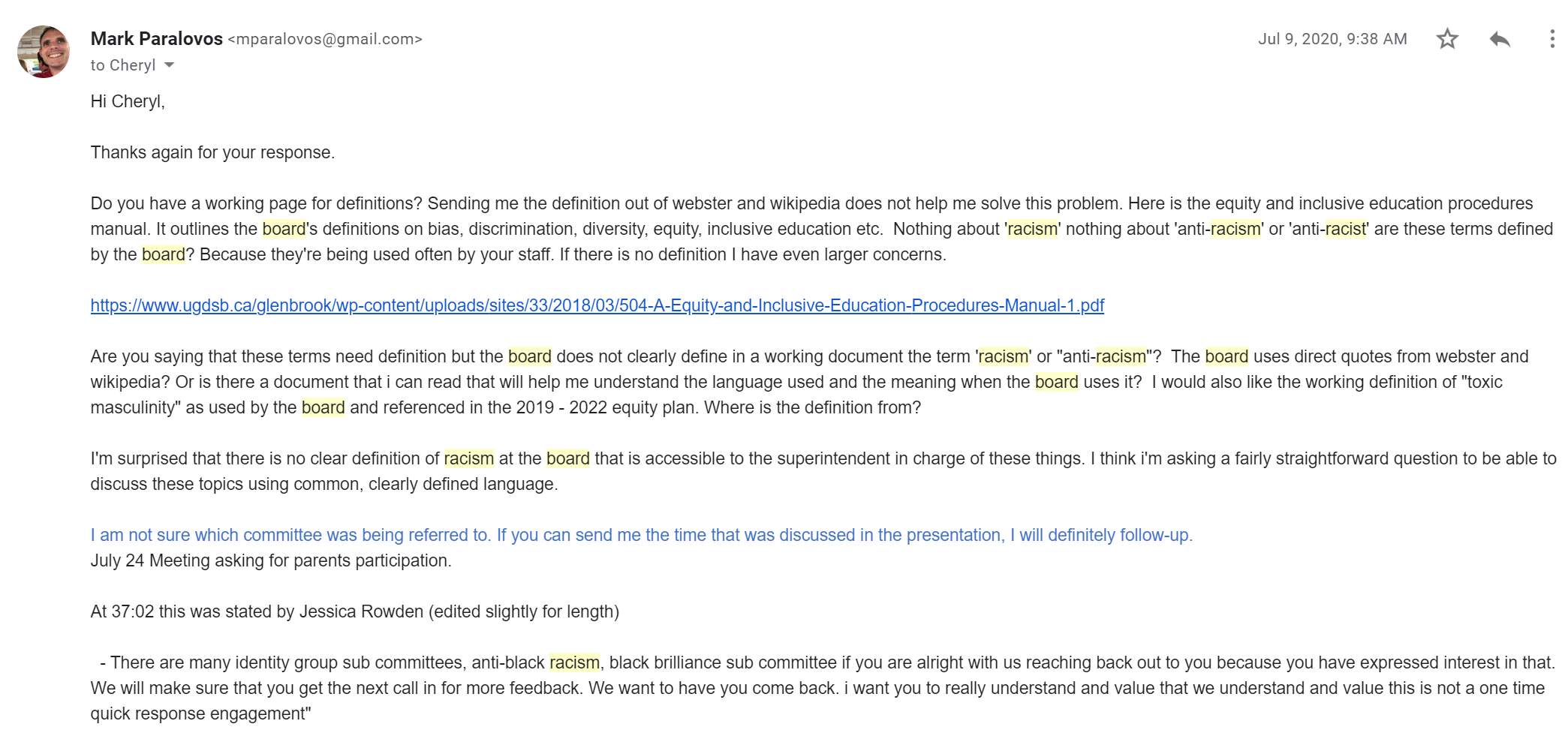A Case Study – Problem Solving a Race Issue with the Upper Grand District School Board 2020 – Part 2
I had my meeting on July 3 with UGDSB Superintendent. We discussed a wide range of topics related to critical race theory and the UGDSB’s equity plan. I will highlight my recollection of the meeting here. The audio recording that i would typically make and reference failed this time, so this is my imperfect recollection from my notes. Apologies if there are any inaccuracies.
We began the meeting very pleasantly. I gave context around the experience I have with having ‘difficult’ conversations. To give context for the reader, I have negotiated union contracts for multiple unions, I was a union steward so I helped the employer meet with employees. These meetings would usually be about known performance issues etc. In addition to working as a union steward and contact negotiator, I worked as a youth care worker and was expected to deal with varying degrees of difficult conversations. So this conversation did not intimidate me in the slightest. I wanted to be honest about what was happening and I wanted to solve this problem that i have identified in the board.
I put a case together that basically outlined that the board is ignoring their own policies in their use of critical race theory in developing policy.
I discussed the britanica definition of critical race theory, an image can be seen below the link.
https://www.britannica.com/topic/critical-race-theory
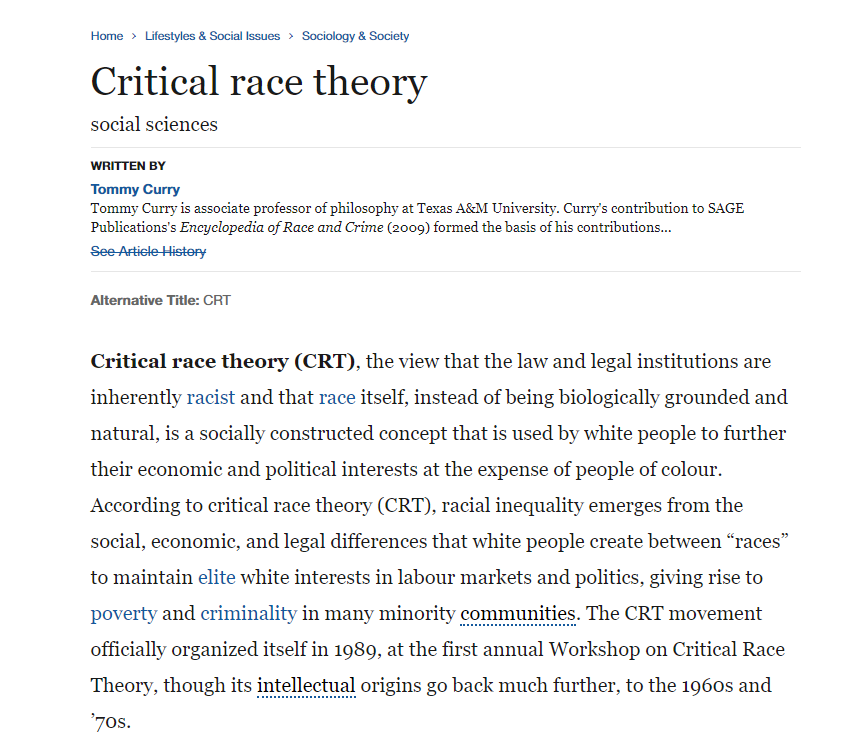
Critical race theory (CRT), the view that the law and legal institutions are inherently racist and that race itself, instead of being biologically grounded and natural, is a socially constructed concept that is used by white people to further their economic and political interests at the expense of people of colour. According to critical race theory (CRT), racial inequality emerges from the social, economic, and legal differences that white people create between “races” to maintain elite white interests in labour markets and politics, giving rise to poverty and criminality in many minority communities.
That’s not the only definition I looked for with regard to critical race theory either. Wikipedia says:
CRT recognizes that racism is ingrained in the fabric and system of the American society. The individual racist need not exist to note that institutional racism is pervasive in the dominant culture. This is the analytical lens that CRT uses in examining existing power structures. CRT identifies that these power structures are based on white privilege and white supremacy, which perpetuates the marginalization of people of color.
Both of these definitions directly blame white people for the ‘perpetuation of marginalization of people of colour.’
The definition of ‘Discrimination’ by the board as referenced in their own policies state:
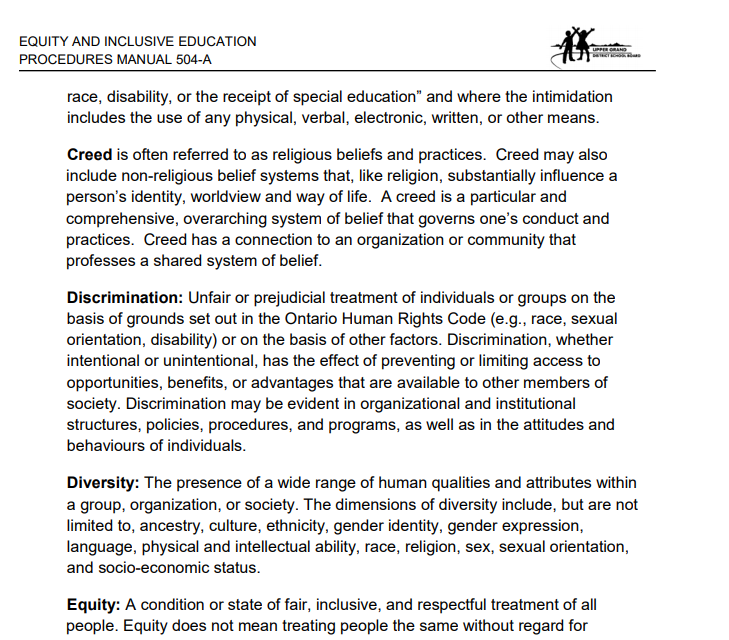
Would it be unfair or prejudicial to claim that all systems built by white people are inherently racist? I believe it would be. Is that an appropriate statement for a UGDSB employee to make? Particularly one who is in charge of the School board Equity Plan?
Would it be unfair or prejudicial to claim that all policies if they aren’t explicitly anti-racist are upholding ‘white supremacy’? I’m still not sure what that statement means in the context of the board. Particularly the part where she says that will become part of the language.
In response to this line of questioning the superintendent stated that critical race theory would not be referenced in any policy documents. The only time it was going to be used was in training administrators (Principals and above) or teachers. I asked for an assurance that critical race theory would not be used in developing policy and did not receive a direct answer.
Here is the resources recommended on the equity and inclusive education page on the board’s website:
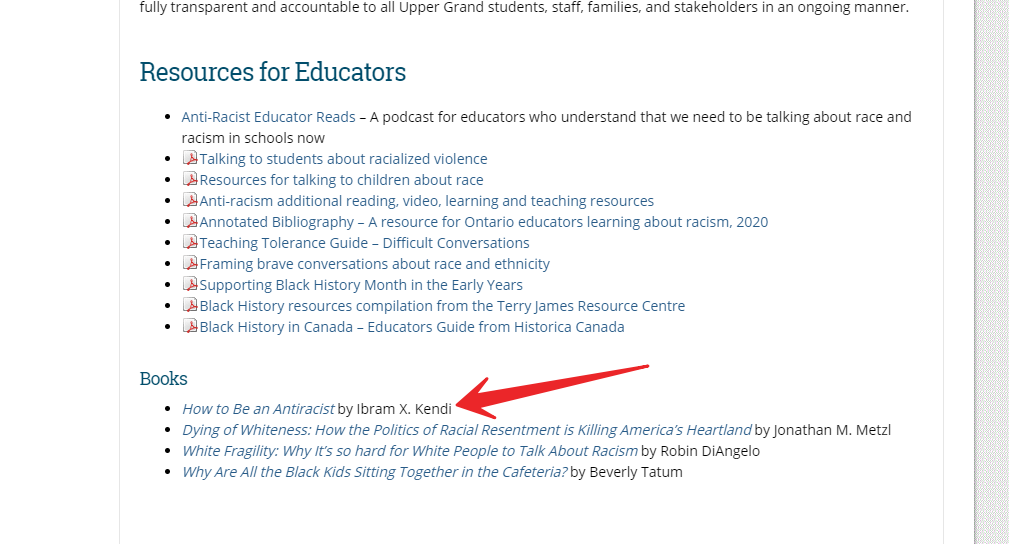
If you look at the books heading you can see ‘How to be an Antiracist.’ Here is a short synopsis and some amazon.com reviews. You can follow the links to see more. But these are not fully fleshed out ideas. The definitions in the book themselves make no sense in any context.

The superintendent asked me to agree that people of colour had not had anywhere in the world to thrive. That the whole world had been built by white people and that we should really be allowing people of colour to be a priority. I can’t remember exact wording here. I responded by pointing out that large parts of the world had been settled and run wholly without white people. I asked if Japan was run or influenced by white people. Or China? Or India. I reiterated that it was important to have perspective about blatantly false statements.
Despite having questions like ‘what does the board mean by race is a social construct’ highlighted and part of my plan to prove discrimination, this question was not definitively answered.
I described the board’s support for black brilliance and anti-black racism sub committees in school and within the context of having those voices represented when crafting policy like the school board equity plan. (backgrounder:This was from the June 24th meeting where Colinda Clyne and Jessica Rowden were encouraging parents to join those sub committees).
I asked for an example of other groups in schools that or other sub committees that would have input into the school board equity plan or groups in schools. I also mentioned a separately staffed ‘black brilliance’ that was focused on academic success for black students etc. The list she gave me included lgbt2q, social justice, community agencies, meti / inuit advisory council, mental health advisory, spec ed, FSLAC (despite being told by a trustee that this was well outside of the scope of FSLAC, apparently this superintendent doesn’t think so).
I said that I appreciated the list she gave me and stated that she gave me a list of stakeholders within the board for the sub committee, but she did not answer about school groups, nor did she give me any examples like ‘anti-black’ racism or black brilliance. I asked for an anti-Asian racism, or anti-brown or anti-white racism, or an Asian brilliance or Brown Brilliance or White Brilliance school group examples. She said that she did not have any.
I said, okay, let me make it more direct. The board enthusiastically embraces black brilliance groups and is pushing for staffing for such a group. The group is focused on academic achievement and is meant to be a supportive and positive thing for all. Could a student approach an administrator and start a white brilliance group. It would behave in exactly the same way as the black brilliance group.
At that point she got visibly uncomfortable.
She said that she thought that a ‘white brilliance’ group would need a lot of careful consideration before being allowed by administration. I referred to my earlier point about discrimination directly effecting the opportunities for all, and this is potentially an example of that.
I said that I worked in schools, and understood that the administrators of the school would steer the student to remove the ‘white’ from the name of the group and encourage them on. I said if students are allowed and encouraged to have a ‘black brilliance’ group why aren’t they allowed and encouraged to have a ‘white brilliance’ group? Why does it have to be racial?
She asked if the student’s idea was to exclude anyone from joining the group and i said that the students in the hypothetical group do not want to exclude anyone and everyone is welcome to join. The point of the group is the same as the black brilliance though, it’s to celebrate white brilliance in just the same way. We talked around this for a while. She did not want to commit to allowing one (But said that i knew she wouldn’t be able to allow something like that – which is totally true. I’ve been around a while. I’ve seen this first hand)
My main point after this was that things like academic brilliance and support shouldn’t be doled out by race, they should be doled out by need. Making it about race adds complexity that is unmanageable and inappropriate.
I was pushing for the definition of racism and the superintendent gave 3 examples.
- Track and Field during Ramadan
- The number of brown students in south Guelph who do not have brown or black teachers
- There are students in the system who have not had their last name pronounced correctly once this year. In response to this one I asked her to pronounce my last name. She couldn’t. I told her that was not an example of racism. We both laughed.
I asked if that was really racism when demographics spoke much more accurately to those issues.
- I am not as well versed in Muslim holidays to discuss the issue intelligently on the fly. The superintendent asked if I thought it was fair that track and field happens during Ramadan. She said ‘we wouldn’t do that over Christmas!’ I agreed and said ‘there must be some reasoning behind not being able to move track and field that is not based in racism.’ However she was confident that racism explained it. Or at least racism explained why the planning committee was resistant to moving it.
After thinking on this and a bit of research (and I mention this in my reply posted below) Ramadan in 2020 was April 23 – May 23. There is good reason in our tight school board calendar for resistance to moving things like track. I also asked for a % number of impacted students in Guelph. She did not have that number. - The superintendent said that she had a high number of student in the south of Guelph that have darker skin but a high percentage (93% – as per June 16 meeting) of Guelph teachers are white. She asked if I didn’t believe that was racism.
I said absolutely not. I said that in the first place even if you could hire based on skin colour, which everyone is aware they cannot, but if they could they STILL wouldn’t be able to move those teachers to the schools they want due to rules in place for filling positions. Regulation 274 if you want to look it up. Oh here it is.
https://www.ontario.ca/laws/regulation/120274
Then I informed her that I had been a Youth Care Worker in the board and that 90% of the kids who are having trouble in classrooms are male (not sourced stat. This is my lived experience.) and have no access to a male support worker. By these rules the board is extremely anti-male. I asked her if she believed that the board were rampantly, systemically anti male. She agreed that it was a big problem and that males just didn’t apply to the job. I thanked her for proving my point. That the Board is struggling to hire competent teachers and that trying to shoehorn in a race base exemption is not making things ‘more fair.’ I underlined again that people should be judged by their actions and who they are and not by the colour of their skin.
She asked me then what happens if her as a principal or an administrator favoured a white colleague by encouraging them to apply for a position over a brown or asian or black colleague if both colleagues were equal. I said it would depend on her motivation. If she were making the call based on skin colour, then of course that is racist. But if she were making the call to satisfy needs of a school that one had over the other then I would attribute it to a deeper pool of white talent based on the board’s 93% white teacher statistic from June 16. It would be equally irresponsible for you to improperly encourage someone who isn’t ready just because they have a skin colour the board is ‘looking for’ further making the case against racializing things like hiring or support.
There were other things discussed. ‘All use bathroom’ – I was concerned that they were going to remove gendered bathrooms entirely. The superintendent assured me they were not intending on doing that.
I asked what “disrupt access to sports programs and trips due to socio economic status sex, gender and ability” (this is found on the 2019 – 2022 equity plan)
She said that the school wanted anyone to be able to try out for any sport. I told her she was going to run into trouble not when the girls are trying out for the boys football team, but when the boys who can’t cut it in track are trying out for the girls team with the view of getting scholarships. This is happening and has been stopped in certain states currently. She was enthusiastic about having anyone be able to try out for anything.
I asked what happened if the girls tried out for the boys team and didn’t make it. Who’s to set the standard? Isn’t the standard itself against the inclusionary theory that is being pushed. She enthusiastically agreed with me, I think, believing that we agreed. I was just trying to show her how it’s a slippery slope when you remove all distinctions.
The superintendent may have a different recollection of the conversation but fundamentally that covers it.
Here is my follow up email. I called her the wrong name at the end of the call. Blerg.


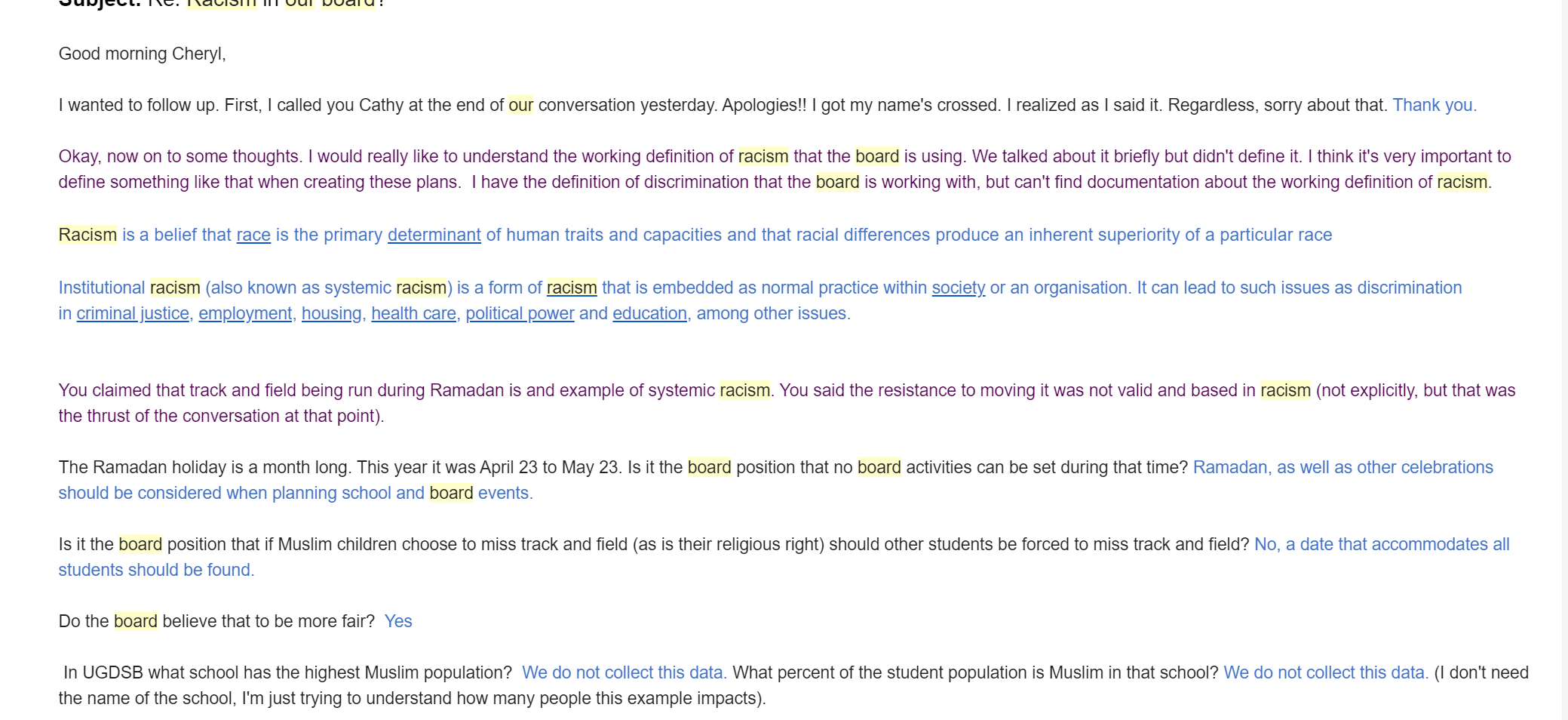
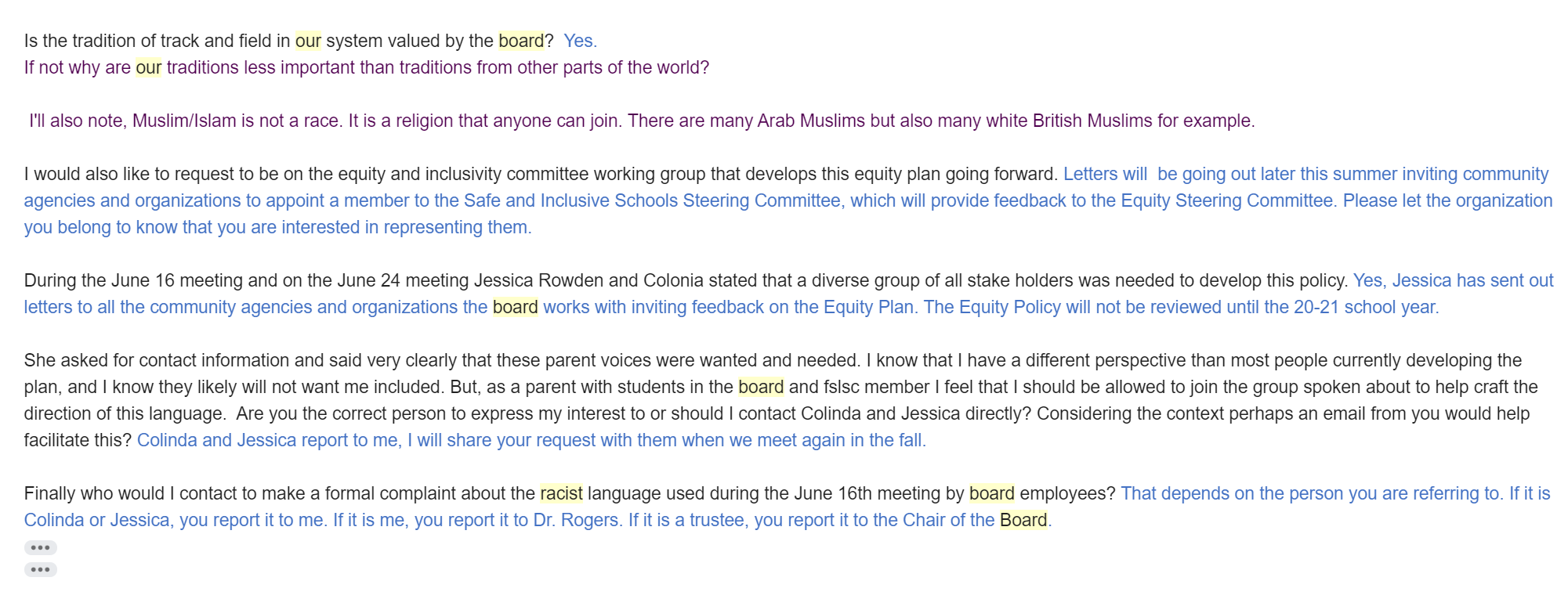

Cheryl’s Response
